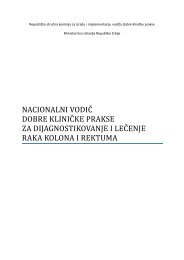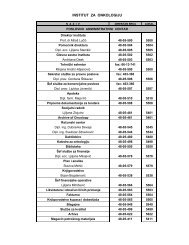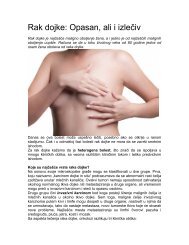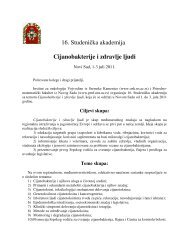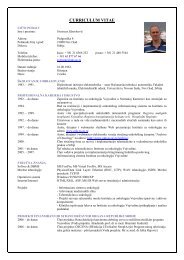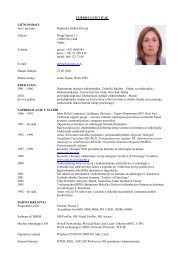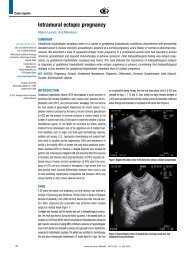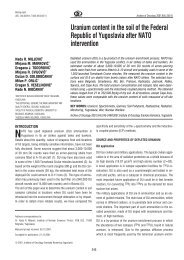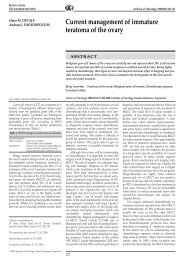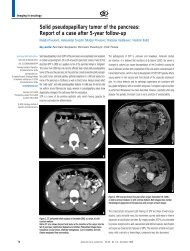Pathogenesis of malignant ascites in ovarian cancer ... - doiSerbia
Pathogenesis of malignant ascites in ovarian cancer ... - doiSerbia
Pathogenesis of malignant ascites in ovarian cancer ... - doiSerbia
Create successful ePaper yourself
Turn your PDF publications into a flip-book with our unique Google optimized e-Paper software.
REVIEW ARTICLE<br />
UDC: 612.627-006:616-092<br />
Arch Oncol 2004;12(2):115-8.<br />
<strong>Pathogenesis</strong> <strong>of</strong> <strong>malignant</strong> <strong>ascites</strong> <strong>in</strong> <strong>ovarian</strong> <strong>cancer</strong> patients<br />
Zorica Stanojeviæ 1 , Gorana Ranèiæ 2 , Stojan Radiæ 1 , Nata¹a Potiæ-Zeèeviæ 1 ,<br />
Biljana Ðorðeviæ 3 , Milan Markoviæ 1 , Il<strong>in</strong>ka Todorovska 1<br />
ABSTRACT<br />
Peritonitis carc<strong>in</strong>omatosa, <strong>in</strong>dicat<strong>in</strong>g the presence <strong>of</strong> <strong>malignant</strong> cells <strong>in</strong> the peritoneal cavity, is a wellknown<br />
complication <strong>of</strong> <strong>malignant</strong> disease. The collection <strong>of</strong> <strong>in</strong>traperitoneal fluid <strong>in</strong> a patient with <strong>ovarian</strong><br />
<strong>cancer</strong> is most likely due to <strong>in</strong>traperitoneal spread <strong>of</strong> disease. The recognition <strong>of</strong> small quantities <strong>of</strong><br />
<strong>in</strong>traperitoneal fluid may have stag<strong>in</strong>g and prognostic significance, while symptomatic large collections<br />
may reflect end-stage disease, which permits only palliative therapeutic options. In this paper, we discussed<br />
the pathogenesis <strong>of</strong> <strong>malignant</strong> <strong>ascites</strong> <strong>in</strong> <strong>ovarian</strong> <strong>cancer</strong> patients and suggested potential new<br />
treatment approaches.<br />
KEY WORDS: Ascites; Ovarian Neoplasms; Neovascularisation, Pathologic; Endothelial Growth Factors;<br />
Capillary Permeability<br />
1<br />
Cl<strong>in</strong>ic <strong>of</strong> Oncology, Cl<strong>in</strong>ical Center Ni¹, Ni¹, 2 Institute <strong>of</strong><br />
Histology, Medical Faculty Ni¹, Ni¹, 3 Institute <strong>of</strong> Pathology,<br />
Medical Faculty Ni¹, Serbia & Montenegro; Address correspondence<br />
to: Pr<strong>of</strong>. Dr. Zorica Stanojeviæ, Cl<strong>in</strong>ic <strong>of</strong><br />
Oncology, Cl<strong>in</strong>ical Center Ni¹, Braæe Taskoviæ 48, 18000<br />
Ni¹, Serbia & Montenegro, E-mail:<br />
marko.st@banker<strong>in</strong>ter.net; The manuscript was received:<br />
20.02.2004, Provisionally accepted: 30.03.2004, Accepted<br />
for publication: 02.04. 2004<br />
© 2004, Institute <strong>of</strong> Oncology Sremska Kamenica, Serbia &<br />
Montenegro<br />
INTRODUCTION<br />
Epithelial <strong>ovarian</strong> <strong>cancer</strong> is the sixth most frequent form <strong>of</strong> <strong>cancer</strong> <strong>in</strong> women worldwide<br />
and the fourth most frequent cause <strong>of</strong> <strong>cancer</strong> death among women <strong>in</strong> both the United<br />
States and the United K<strong>in</strong>gdom. At the same time it is the second most common gynecologic<br />
malignancy and the most frequent cause <strong>of</strong> death from gynecologic <strong>cancer</strong> <strong>in</strong> the<br />
developed countries (1,2). At the time <strong>of</strong> diagnosis the majority <strong>of</strong> patients will present with<br />
advanced disease (FIGO stage III-IV) because the disease is <strong>of</strong>ten asymptomatic <strong>in</strong> its early<br />
stage (3). Follow<strong>in</strong>g primary surgical cytoreduction, the current standard treatment for<br />
patients with advanced <strong>ovarian</strong> <strong>cancer</strong> <strong>in</strong>volves the systemic adm<strong>in</strong>istration <strong>of</strong> a paclitaxel<br />
and plat<strong>in</strong>um-conta<strong>in</strong><strong>in</strong>g chemotherapy regiments.<br />
Despite the fact that it is one <strong>of</strong> the most chemosensitive <strong>cancer</strong>s, with response rate to<br />
plat<strong>in</strong>um-conta<strong>in</strong><strong>in</strong>g regiments <strong>of</strong> greater than 60% (4) and <strong>in</strong>travenous paclitaxel greater<br />
than 80% (5), the prognosis rema<strong>in</strong>s poor with a 5-year survival rate <strong>of</strong> approximately 15%-<br />
20% <strong>in</strong> stage III and less than 5% <strong>in</strong> stage IV patients (6). The largely unchanged mortality<br />
rate from <strong>ovarian</strong> <strong>cancer</strong> reflects its late cl<strong>in</strong>ical appearance. Two-thirds <strong>of</strong> the patients are<br />
diagnosed with stage III or IV disease, commonly associated with the accumulation <strong>of</strong><br />
ascitic fluid <strong>in</strong> the peritoneal cavity (7).<br />
Many diseases are complicated by the accumulation <strong>of</strong> free fluid with<strong>in</strong> the peritoneal cavity<br />
i.e. the onset <strong>of</strong> <strong>ascites</strong>. The most common cause <strong>of</strong> <strong>ascites</strong> is liver cirrhosis, but <strong>in</strong><br />
about 20% <strong>of</strong> cases there is an extrahepatic cause. Runyon and colleagues (8) reported that<br />
parenchymal liver diseases are the most common cause <strong>in</strong> about 80%, then malignancy <strong>in</strong><br />
10%, heart failure <strong>in</strong> 5%, tuberculosis 2%, and other causes <strong>in</strong> the rest 3% <strong>of</strong> cases.<br />
Ascites is a common and distress<strong>in</strong>g complication <strong>of</strong> human abdom<strong>in</strong>al <strong>cancer</strong>, <strong>in</strong>clud<strong>in</strong>g<br />
<strong>ovarian</strong> <strong>cancer</strong> (9,10). The collection <strong>of</strong> <strong>in</strong>traperitoneal fluid <strong>in</strong> a patient with <strong>ovarian</strong> <strong>cancer</strong><br />
is most likely due to <strong>in</strong>traperitoneal spread <strong>of</strong> disease and if neoplastic cells are identified,<br />
the term <strong>malignant</strong> <strong>ascites</strong> is used. This f<strong>in</strong>d<strong>in</strong>g has multiple implications: (1) the recognition<br />
<strong>of</strong> small quantities <strong>of</strong> <strong>in</strong>traperitoneal fluid may have stag<strong>in</strong>g and prognostic significance,<br />
(2) symptomatic large collections are a sign <strong>of</strong> dissem<strong>in</strong>ated carc<strong>in</strong>omatosis and may<br />
reflect end-stage disease which permits only palliative therapeutic options, and (3) the presence<br />
<strong>of</strong> <strong>malignant</strong> <strong>ascites</strong> may be part <strong>of</strong> a cl<strong>in</strong>ical picture amenable to curative efforts. In<br />
such cases strategies aimed at obta<strong>in</strong><strong>in</strong>g regression <strong>of</strong> tumor and prolongation <strong>of</strong> survival<br />
should be considered.<br />
SYMPTOMS AND SIGNS<br />
Abdom<strong>in</strong>al distension and changes <strong>in</strong> abdom<strong>in</strong>al girth are the classic symptoms <strong>of</strong> <strong>ascites</strong>.<br />
Signs <strong>of</strong> <strong>ascites</strong> <strong>in</strong>clude dullness to percussion, shift<strong>in</strong>g dullness, and fluid wave. These<br />
may be totally absent if effusions are 100 ml or less. Smaller effusions, which are not cl<strong>in</strong>ically<br />
evident, may be diagnosed <strong>in</strong>cidentally dur<strong>in</strong>g the workup <strong>of</strong> malignancy by radiological<br />
techniques (ultrasonography, computed tomography, or magnetic resonance imag<strong>in</strong>g)<br />
(11-13). The ascitic fluid should be evaluated for various chemistry values (8,14,15). Some<br />
biochemical, cytological and microbiological analysis <strong>of</strong> ascitic fluid and serum, used alone<br />
or <strong>in</strong> comb<strong>in</strong>ation, can help <strong>in</strong> differential diagnosis <strong>of</strong> <strong>ascites</strong>.<br />
MORPHOLOGIC CHARACTERISTICS OF THE PERITONEAL MEMBRANE<br />
In physiological conditions, a basic pr<strong>in</strong>ciple <strong>of</strong> capillary fluid hemodynamics is the relative<br />
capillary impermeability to prote<strong>in</strong>s while fluid and solutes are able to pass the membrane<br />
relatively easily. As a consequence, differences <strong>in</strong> prote<strong>in</strong> concentration across the capillary<br />
membrane are present and oncotic pressure differences are created. Those differences<br />
<strong>in</strong> oncotic pressure limit net capillary fluid-filtration and prevent edema formation due to<br />
reabsorption fluid from the <strong>in</strong>terstitial space.<br />
The microscopic picture <strong>of</strong> peritoneal membrane shows, apart from the capillary endothelium<br />
and basement membrane, three dist<strong>in</strong>ct barriers which prevent the loss <strong>of</strong> prote<strong>in</strong>s <strong>in</strong>to<br />
the peritoneal cavity: the <strong>in</strong>terstitial stoma, the mesothelial basement membrane, and the<br />
mesothelial cells l<strong>in</strong><strong>in</strong>g the peritoneum (Figure 1).<br />
www.onk.ns.ac.yu/Archive August 10, 2004<br />
115
Stanojeviæ Z. et al.<br />
at the <strong>in</strong>itial lymphatics. The necessary osmotic force can be created by active<br />
transendothelial transport <strong>of</strong> album<strong>in</strong> (20).<br />
CHARACTERISTICS OF MALIGNANT ASCITES<br />
Malignant <strong>ascites</strong> is characterized by positive cytology <strong>of</strong> <strong>malignant</strong> cells, large number <strong>of</strong><br />
white blood cells and a higher lactate dehydrogenase level (14, 21). Interest<strong>in</strong>gly, the ma<strong>in</strong><br />
ascitic fluid prote<strong>in</strong>-levels are high <strong>in</strong> patients with peritonitis carc<strong>in</strong>omatosa, as are <strong>ascites</strong><br />
album<strong>in</strong> concentrations (21).<br />
The data show <strong>in</strong>traperitoneal prote<strong>in</strong> and album<strong>in</strong> accumulation <strong>in</strong> <strong>malignant</strong> <strong>ascites</strong>. What<br />
are the reasons for impaired dra<strong>in</strong>age or <strong>in</strong>creased production?<br />
Fluid accumulation occurs if lymphatic dra<strong>in</strong>age <strong>of</strong> peritoneal cavity is compromised or if<br />
net filtration is <strong>in</strong>creased, overwhelm<strong>in</strong>g the lymphatic capacity. In <strong>malignant</strong> <strong>ascites</strong>, fluid<br />
accumulation is the result <strong>of</strong> filtration m<strong>in</strong>us dra<strong>in</strong>age (Figure 2).<br />
Figure 1. Schematic presentation <strong>of</strong> peritoneal <strong>in</strong>terstitium 1. Interstitial space, 2. Mesothelial cells,<br />
3. Fibrocyte, 4. Proteoglycans, 5. Collagen fibers, 6. Endothelial cell, 7. Basal lam<strong>in</strong>a<br />
Endothelial cells present the first barrier follow<strong>in</strong>g the route from the <strong>in</strong>travascular to the<br />
<strong>in</strong>traperitoneal space. Those cells have an extraperitoneal glycocalyx with fixed anionic<br />
charges, which is difficult to pass for album<strong>in</strong>. Album<strong>in</strong>s, as anionic macromolecules, considerably<br />
contribute to plasma oncotic pressure (16). Peritoneal endothelial cells are l<strong>in</strong>ked<br />
with tight junctions, so transendothelial transport is through the <strong>in</strong>tracellular pores (17).<br />
Endothelial basement membrane separates endothelial cells from the <strong>in</strong>terstitial space.<br />
Proteoglycans present <strong>in</strong> the basement membrane constitute a negative charge reticulum,<br />
which aga<strong>in</strong> is a selective barrier for anionic prote<strong>in</strong>s. The <strong>in</strong>terstitial space consists <strong>of</strong><br />
loose connective tissue composed <strong>of</strong> fibroblasts, collagen, hyaluronic acid, and negatively<br />
charged macromolecules. Hyaluronic acid b<strong>in</strong>ds a considerable amount <strong>of</strong> water. The <strong>in</strong>terstitial<br />
space acts as a filter and reduces or blocks diffusion <strong>of</strong> macromolecules. The submesothelial<br />
basement membrane is a cont<strong>in</strong>uous layer at the <strong>in</strong>terstitial site <strong>of</strong> the mesothelial<br />
cells. Negatively charged glycosam<strong>in</strong>oglycans are also present at this site. Mesothelial<br />
cells present the last barrier to be passed. The mesothelium consists <strong>of</strong> a monolayer <strong>of</strong> flat<br />
cells with a total estimated surface <strong>of</strong> approximately two square meters. Mesothelial cells<br />
are functionally similar to endothelial cells. They have glycocalyx conta<strong>in</strong><strong>in</strong>g anionic<br />
charges and transcellular channels for macromolecular transport. In summary, the presence<br />
<strong>of</strong> tight junctions between the endothelial cells <strong>in</strong> the peritoneal capillaries and the<br />
presence <strong>of</strong> negatively charged macromolecules at several extracellular sites produce an<br />
effective barrier aga<strong>in</strong>st leakage <strong>of</strong> negatively charged molecules such as album<strong>in</strong> from<br />
plasma to the peritoneal cavity. Those anatomic structures prevent excessive fluid-filtration<br />
from the capillaries to the peritoneum. The peritoneal lymphatic system collects fluid, prote<strong>in</strong>s,<br />
other macromolecules and cells and returns them to systemic circulation. The lymphatic<br />
capillary net is organized as a plexus along the submesothelial surface and dra<strong>in</strong>s to<br />
lymph vessels. Those have smooth muscle cells and are <strong>in</strong>nervated. Contractions <strong>of</strong> lymph<br />
vessels are generated by myogenic stimuli, and are <strong>in</strong>fluenced at least by activation <strong>of</strong> a-<br />
adrenovasoactive peptides. The anatomic features <strong>of</strong> peritoneal lymphatic system are the<br />
so-called stomata. The stomata serve for open communications between the abdom<strong>in</strong>al<br />
cavity and the submesothelial diaphragmatic lymphatics. They play a major role <strong>in</strong> peritoneal<br />
lymphatic dra<strong>in</strong>age, s<strong>in</strong>ce most <strong>in</strong>traperitoneal fluid is absorbed at this site (16).<br />
What are the mechanisms <strong>in</strong>volved <strong>in</strong> lymph formation? Those mechanisms are still<br />
unclear. A hydraulic pressure theory was proposed <strong>in</strong> the early 1930's <strong>of</strong> the last century<br />
(18). Normally, the <strong>in</strong>terstitial pressure is negative, thus an <strong>in</strong>crease <strong>in</strong> <strong>in</strong>traabdom<strong>in</strong>al pressure<br />
leads to <strong>in</strong>creased lymph production (19). Another hypothesis has focused on osmotic<br />
forces as a dom<strong>in</strong>ant factor. This theory postulates a prote<strong>in</strong> concentrat<strong>in</strong>g mechanisms<br />
Figure 2. Proposed pathogenesis <strong>of</strong> <strong>malignant</strong> <strong>ascites</strong>. * VEGF - vascular endothelial growth factor;<br />
b-FGF - basic-fibroblastic growth factor; TGFa and b - transform<strong>in</strong>g growth factor a and b; IL-8<br />
- <strong>in</strong>terleuk<strong>in</strong>-8; ** Starl<strong>in</strong>gÕs low <strong>of</strong> capillary hemodynamics: LpS[(Pcap -Pif) - s (pcap - pif)],<br />
***Changes <strong>in</strong> the balance between the capillary and <strong>in</strong>terstitial oncotic forces(pcap- pif)<br />
There is evidence <strong>of</strong> impaired lymphatic dra<strong>in</strong>age <strong>in</strong> peritonitis carc<strong>in</strong>omatosa, especially<br />
alterations <strong>in</strong> diaphragmatic and retrosternal lymph vessels (22). Decreased lymphatic<br />
dra<strong>in</strong>age is a contribut<strong>in</strong>g factor <strong>in</strong> the pathogenesis <strong>of</strong> <strong>malignant</strong> <strong>ascites</strong> (23). In addition<br />
to impaired lymphatic dra<strong>in</strong>age, there is evidence <strong>of</strong> six-to sixteen-fold <strong>in</strong>creased fluid production<br />
(9). Accord<strong>in</strong>g to the Starl<strong>in</strong>g's law <strong>of</strong> capillary hemodynamics, exchange <strong>of</strong> fluid<br />
between the plasma and the <strong>in</strong>terstitium is determ<strong>in</strong>ed by the hydraulic and oncotic pressure<br />
<strong>in</strong> each compartment (24).<br />
Net filtration = LpS (d hydraulic pressure - d oncotic pressure) = LpS [(P cap -P if ) - s (p cap<br />
- p if )]; Lp - unit permeability or porosity <strong>of</strong> the capillary wall; S - surface area available for<br />
filtration; P cap and P if - capillary and <strong>in</strong>terstitial fluid hydraulic pressures; p cap and p if - capillary<br />
and <strong>in</strong>terstitial fluid oncotic pressures; s - reflection coefficient <strong>of</strong> prote<strong>in</strong>s across the<br />
capillary wall with values rang<strong>in</strong>g from 0, if completely permeable, to 1 if completely impermeable<br />
(24).<br />
www.onk.ns.ac.yu/Archive August 10, 2004<br />
116
<strong>Pathogenesis</strong> <strong>of</strong> <strong>malignant</strong> <strong>ascites</strong><br />
An <strong>in</strong>crease <strong>of</strong> net filtration and ascitic fluid accumulation is a result <strong>of</strong> (1) <strong>in</strong>creased capillary<br />
permeability, (2) <strong>in</strong>creased surface area available for filtration, (3) <strong>in</strong>creased hydraulic<br />
pressure difference, and (4) decreased oncotic pressure difference, or a comb<strong>in</strong>ation <strong>of</strong><br />
these factors.<br />
Increased capillary permeability<br />
In peritonitis carc<strong>in</strong>omatosa, <strong>in</strong>creased permeability to prote<strong>in</strong>s and new capillaries were<br />
observed. Inhibition <strong>of</strong> angiogenesis with locally adm<strong>in</strong>istered protam<strong>in</strong>e prevents new capillaries<br />
from develop<strong>in</strong>g and also prevents the occurrence <strong>of</strong> <strong>ascites</strong> <strong>in</strong> experimental models<br />
(25). It has generally been considered that factors, which are produced by tumor cells<br />
and which <strong>in</strong>crease vascular permeability and <strong>in</strong>duce angiogenesis, are present <strong>in</strong> <strong>malignant</strong><br />
ascitic fluid and contribute to its development (26). Angiogenesis starts from stimulation<br />
<strong>of</strong> the endothelium, result<strong>in</strong>g <strong>in</strong> hyperpermeability <strong>of</strong> the endothelial membrane and<br />
degradation <strong>of</strong> the basement membrane and underly<strong>in</strong>g stroma. The migration and proliferation<br />
<strong>of</strong> endothelial cells is the next step, and the formation <strong>of</strong> new blood vessels and capillaries<br />
is the second one. Vascular endothelial growth factor (VEGF) is not the only one out<br />
<strong>of</strong> the most potent and specific angiogenic factors, but it also stimulates vascular permeability<br />
(27,28).<br />
VEGF has been identified <strong>in</strong> <strong>ovarian</strong> tumor cells (29) and <strong>in</strong>creased VEGF gene expression<br />
is seen <strong>in</strong> neoplastic human ovaries (30). Nagy et al. (31), us<strong>in</strong>g a mouse model showed<br />
that carc<strong>in</strong>oma cells <strong>in</strong>jected <strong>in</strong>to the peritoneal cavity resulted <strong>in</strong> VEGF <strong>in</strong>duced peritoneal<br />
capillary permeability and leakage <strong>of</strong> plasma prote<strong>in</strong>s, <strong>in</strong>clud<strong>in</strong>g album<strong>in</strong> and fibr<strong>in</strong>(ogen),<br />
from newly developed capillaries. Other factors that stimulate tumor cells growth, which<br />
may also <strong>in</strong>duce angiogenesis, have been identified <strong>in</strong> <strong>malignant</strong> <strong>ascites</strong> and <strong>in</strong>clude basic<br />
fibroblast growth factor (bFGF) and angiogen<strong>in</strong> (29), transform<strong>in</strong>g growth factors a and b<br />
(TGF-a and b) (32) and <strong>in</strong>terleuk<strong>in</strong>-8 (33). Epidermal growth factor (EGF) and TGF-a have<br />
been shown to be produced by some tumor cell/types and these factors promote <strong>ascites</strong><br />
formation <strong>in</strong> mice (34). Richardson et al. (35) observed a marked loss <strong>of</strong> capillary vessels,<br />
consistent with the possibility that <strong>malignant</strong> <strong>ascites</strong> fluid conta<strong>in</strong>s cytok<strong>in</strong>es with apparently<br />
oppos<strong>in</strong>g effect. The authors identified angiostat<strong>in</strong> by SDS-PAGE / Western blot analysis<br />
<strong>in</strong> human <strong>ovarian</strong> and gastric derived <strong>ascites</strong> and demonstrated its biological activity.<br />
The conclusion was that proteases produced by <strong>ovarian</strong> <strong>cancer</strong> cells grown <strong>in</strong> vitro are<br />
capable <strong>of</strong> convert<strong>in</strong>g plasm<strong>in</strong>ogen to angiostat<strong>in</strong>. The orig<strong>in</strong> <strong>of</strong> angiostat<strong>in</strong> <strong>in</strong> <strong>malignant</strong><br />
<strong>ascites</strong> fluid is not certa<strong>in</strong>. Circulat<strong>in</strong>g angiostat<strong>in</strong> has been implicated <strong>in</strong> the suppression <strong>of</strong><br />
secondary tumor growth (36), although the precise mechanism by which it is elaborated <strong>in</strong><br />
vivo by the primary tumor has not been def<strong>in</strong>ed (37). But <strong>in</strong> vitro, it is generated by the<br />
cleavage <strong>of</strong> plasm<strong>in</strong>ogen by proteases <strong>in</strong>clud<strong>in</strong>g pancreatic elastase, ur<strong>in</strong>ary-type plasm<strong>in</strong>ogen<br />
activator (uPA), and macrophage-derived metalloprote<strong>in</strong>ase (MMP)-12 and MMP-<br />
9 (38). O'Mahony et al. (39) showed that human pancreatic <strong>cancer</strong> cells produce uPA,<br />
which is capable <strong>of</strong> degrad<strong>in</strong>g plasm<strong>in</strong>ogen to angiostat<strong>in</strong>. Cystic fluid from patients with<br />
<strong>ovarian</strong> <strong>cancer</strong> conta<strong>in</strong>s uPA and plasm<strong>in</strong>ogen activator <strong>in</strong>hibitor-I. uPA production by <strong>ovarian</strong><br />
<strong>cancer</strong> cells but not by normal <strong>ovarian</strong> epithelium has been clearly recognized (40).<br />
Ovarian <strong>cancer</strong> cells also produce MMP-9 (41). However, these enzymes had been implicated<br />
<strong>in</strong> the breakdown <strong>of</strong> extracellular tissue via the production <strong>of</strong> plasm<strong>in</strong>, thereby<br />
<strong>in</strong>creas<strong>in</strong>g the metastatic potential rather than a possible breakdown <strong>of</strong> plasm<strong>in</strong>ogen to<br />
angiostat<strong>in</strong>. On the other side, Westphal et al. (42) showed that the conditioned medium for<br />
human <strong>ovarian</strong> epithelial carc<strong>in</strong>oma cells <strong>in</strong> vitro will degrade human plasm<strong>in</strong>ogen to angiostat<strong>in</strong><br />
and Buick et al. (43) confirmed this observation us<strong>in</strong>g SFCM from HEY cells, an <strong>ovarian</strong><br />
epithelial <strong>cancer</strong> cell l<strong>in</strong>e. It is therefore likely that the angiostat<strong>in</strong> <strong>in</strong> <strong>malignant</strong> <strong>ascites</strong> is<br />
generated from plasm<strong>in</strong>ogen, which has been degraded by proteases produced by <strong>malignant</strong><br />
<strong>ovarian</strong> epithelial cells. It is not known whether the angiostat<strong>in</strong> concentration <strong>in</strong> whole<br />
<strong>malignant</strong> <strong>ascites</strong> fluid is potentially effective as an anti-angiogenic agent. However, low<br />
<strong>in</strong>cidence <strong>of</strong> extraperitoneal metastatic disease <strong>in</strong> <strong>ovarian</strong> <strong>cancer</strong> patients (approximately<br />
16% present with stage IV disease) is related to suppression <strong>of</strong> angiogenesis. Hari et al.<br />
(44) referred that angiostat<strong>in</strong> <strong>in</strong>duces mitotic cell death <strong>of</strong> proliferat<strong>in</strong>g endothelial cells as<br />
the targets. But, there is a possibility that once angiogenesis is established <strong>in</strong> patients, naturally<br />
occurr<strong>in</strong>g angiostat<strong>in</strong> is no longer effective. The adm<strong>in</strong>istration <strong>of</strong> an antiangiogenic<br />
agent may be less effective than prevention <strong>of</strong> action <strong>of</strong> pro-angiogenic agents such as<br />
VEGF, thereby promot<strong>in</strong>g the activity <strong>of</strong> the naturally occurr<strong>in</strong>g anti-angiogenic agents.<br />
These data suggest that the progression <strong>of</strong> the tumor and the development <strong>of</strong> <strong>ascites</strong> may<br />
depend on a balance between the production <strong>of</strong> pro- and anti- angiogenic factors. The more<br />
complete understand<strong>in</strong>g <strong>of</strong> the relative contributions <strong>of</strong> these factors will promote the development<br />
<strong>of</strong> improved treatment. Malignant <strong>ascites</strong> production, but not tumor growth, was<br />
completely <strong>in</strong>hibited <strong>in</strong> mice when treated with function-block<strong>in</strong>g VEGF antibodies (45) and<br />
developed aga<strong>in</strong> with<strong>in</strong> two weeks after the treatment was stopped. These positive experimental<br />
results have been confirmed by others us<strong>in</strong>g anti-VEFG antibodies, VEGF tyros<strong>in</strong>e<br />
k<strong>in</strong>ase receptor <strong>in</strong>hibitors or exogenous soluble human VEGF receptor (46).<br />
Increased surface area for filtration<br />
After <strong>in</strong>traperitoneal tumor cell <strong>in</strong>jection <strong>in</strong> mice, size and number <strong>of</strong> peritoneal l<strong>in</strong><strong>in</strong>g<br />
microvessels and subsequently cross sectional area <strong>in</strong>creased (31). The site <strong>of</strong> production<br />
<strong>of</strong> <strong>malignant</strong> <strong>ascites</strong> is the tumor-free omentum small bowel surface and tumor surface.<br />
Hirabayashi and Graham (9) concluded, "undoubtedly fluid exuded from the tumor surface<br />
but the lion's share came from the disease-free peritoneum". In human subjects, tumor-free<br />
peritoneal surface is able to produce surplus <strong>of</strong> fluid <strong>in</strong> <strong>malignant</strong> <strong>ascites</strong>.<br />
Increased hydraulic pressure difference<br />
Hirabayashi and Graham (9) reported a m<strong>in</strong>or <strong>in</strong>crease <strong>in</strong> portal ve<strong>in</strong> pressure <strong>in</strong> <strong>ovarian</strong><br />
<strong>cancer</strong> patients with <strong>ascites</strong>.<br />
Decreased oncotic pressure difference<br />
In physiologic conditions, album<strong>in</strong> is known to be an effective osmol that contributes to<br />
<strong>in</strong>travascular oncotic pressure, necessary to reabsorb fluid from the <strong>in</strong>terstitial space. If the<br />
oncotic pressure difference decreases, reabsorption decreases and <strong>in</strong>terstitial fluid accumulation<br />
results. In peritonitis carc<strong>in</strong>omatosa, prote<strong>in</strong> degradation to smaller peptides and<br />
am<strong>in</strong>o acids contribute to <strong>in</strong>tra-abdom<strong>in</strong>al oncotic pressure and fluid may be filtrated <strong>in</strong>to<br />
the peritoneal cavity.<br />
In conclusion, <strong>ascites</strong> is a common and distress<strong>in</strong>g complication <strong>of</strong> <strong>ovarian</strong> <strong>cancer</strong>. The<br />
source <strong>of</strong> <strong>malignant</strong> ascitic fluid is likely the non-<strong>cancer</strong>-bear<strong>in</strong>g peritoneal surface rather<br />
than the tumor. The <strong>in</strong>creas<strong>in</strong>g net capillary fluid-production is due to an <strong>in</strong>crease <strong>of</strong> overall<br />
capillary membrane surface, <strong>in</strong>creased capillary permeability and subsequent <strong>in</strong>crease <strong>of</strong><br />
<strong>in</strong>traperitoneal prote<strong>in</strong> concentration, lead<strong>in</strong>g to <strong>in</strong>creased <strong>in</strong>traperitoneal oncotic pressure.<br />
It has generally been considered that factors which are produced by tumor cells (VEGF and<br />
b-FGF) and which <strong>in</strong>crease vascular permeability and <strong>in</strong>duce angiogenesis are present <strong>in</strong><br />
<strong>malignant</strong> <strong>ascites</strong> fluid and contribute to its development. Interference with these mediators<br />
may serve as a target <strong>in</strong> future therapeutic strategies.<br />
REFERENCES<br />
1. Bray F, Sankila R, Ferlay J, Park<strong>in</strong> DM. Estimates <strong>of</strong> <strong>cancer</strong> <strong>in</strong>cidence and mortality <strong>in</strong> Europe <strong>in</strong><br />
1995. Eur J Cancer 2002;38:99-166.<br />
2. Park<strong>in</strong> DM, Pisani P, Ferlay J. Global <strong>cancer</strong> statistics. CA Cancer J Cl<strong>in</strong> 1999;49:33-64.<br />
3. Cannistra SA. Cancer <strong>of</strong> the ovary. N Engl J Med 1993;329:1550-9.<br />
4. Conte PF, Cianci C, Gadducci A. Update <strong>in</strong> the management <strong>of</strong> advanced <strong>ovarian</strong> carc<strong>in</strong>oma. Crit<br />
Rev Oncol Hematol 1999;32:49-58.<br />
www.onk.ns.ac.yu/Archive August 10, 2004<br />
117
Stanojeviæ Z. et al.<br />
5. Mc Guire WP, Hosk<strong>in</strong>s WJ, Brady MF et al. Cyclophosphamide and cisplat<strong>in</strong> compared with paclitaxel<br />
and cisplat<strong>in</strong> <strong>in</strong> patients with stage III and stage IV <strong>ovarian</strong> <strong>cancer</strong>. N Engl J Med 1996;334:1-6.<br />
6. Ozols RF, Rub<strong>in</strong> SC, Thomas G, Robloy S. Epithelial <strong>ovarian</strong> <strong>cancer</strong>. In: Hosk<strong>in</strong>s WJ, Perez CA,<br />
Young RC, editors. Pr<strong>in</strong>ciples and practice <strong>of</strong> gynecologic oncology. 2nd ed. Philadelphia:<br />
Lipp<strong>in</strong>cott-Raven; 1997. p. 941.<br />
7. Petterson F. International Federation <strong>of</strong> Gynecology and Obstetrics: annual report <strong>of</strong> the results<br />
<strong>of</strong> treatment <strong>in</strong> gynecological <strong>cancer</strong>. Stocholm: Panorama Press AB; 1995. p. 83-227.<br />
8. Runyon BA, Montano AA, Akriviadis EA, Antillion MR, Irv<strong>in</strong>g MA, McHutch<strong>in</strong>son JG. The serum<strong>ascites</strong><br />
album<strong>in</strong> gradient is superior to the exudate-transudate concept <strong>in</strong> the differential diagnosis<br />
<strong>of</strong> <strong>ascites</strong>. Ann Intern Med 1992;117:215-9.<br />
9. Hirabayashi K, Graham J. Genesis <strong>of</strong> <strong>ascites</strong> <strong>in</strong> <strong>ovarian</strong> <strong>cancer</strong>. Am J Obstet Gynecol<br />
1970;106:492-7.<br />
10. Runyon BA. Care <strong>of</strong> patients with <strong>ascites</strong>. N Engl J Med 1994;330:337-42.<br />
11. Goldberg BB, Goodman GA, Clearfield HR. Evaluation <strong>of</strong> <strong>ascites</strong> by ultrasound. Radiology<br />
1970;96:15-9.<br />
12. Chang KJ, Alberts CG, Nguyen P. Endoscopic ultrasound-guided f<strong>in</strong>e needle aspiration <strong>of</strong> pleural<br />
and ascitic fluid. Am J Gastroenterol 1995;90:148-53.<br />
13. Sato S, Yokoyama Y, Sakamoto T, Futagami M, Saito Y. Usefulness <strong>of</strong> mass screen<strong>in</strong>g for <strong>ovarian</strong><br />
carc<strong>in</strong>oma us<strong>in</strong>g transvag<strong>in</strong>al ultrasonograpy. Cancer 2000;89:582-8.<br />
14. Bjelakoviæ G, Tasiæ T, Stamenkoviæ I, Stojkoviæ M, Katiæ V, Ota¹eviæ M et al. Biochemical, cytological<br />
and microbiological characteristics <strong>of</strong> the cirrhotic, <strong>malignant</strong> and "mixed" <strong>ascites</strong>. Arch<br />
Oncol 2001;9(2):95-101.<br />
15. Bansal S, Kaur K, Bansal AK. Diagnos<strong>in</strong>g ascitic etiology on a biochemical basis. Hepato<br />
Gastroenterol 1998;45:1673-7.<br />
16. Gotloib L, Shostak A. The functional anatomy <strong>of</strong> the peritoneum as a dialyz<strong>in</strong>g membrane. In:<br />
Twardowski ZJ, Nolph KD, Khanna R, editors. Contemporary Issues <strong>in</strong> Nephrology, vol. 22.<br />
Peritoneal Dialysis: New Concepts and Applications. New York: Churchill Liv<strong>in</strong>gstone; 1990. p.1-29.<br />
17. Renk<strong>in</strong> EM. Some consequences <strong>of</strong> capillary permeability to macromolecules: Stal<strong>in</strong>g's hypothesis<br />
reconsidered. Am J Physol 1986; 250(5Pt2): H706-H710.<br />
18. Allen L. Volume and pressure changes <strong>in</strong> term<strong>in</strong>al lymphatics. Am J Physiol 1931;123:3.<br />
19. Z<strong>in</strong>k J, Greenway CV. Control <strong>of</strong> <strong>ascites</strong> absorption <strong>in</strong> anesthetized cats: Effects <strong>of</strong> <strong>in</strong>traperitoneal<br />
pressure, prote<strong>in</strong> and furosemide diuretics. Gastroenterology 1977; 73(5):1119-24.<br />
20. Shasby DM, Shasby SS. Active transendothelial transport <strong>of</strong> album<strong>in</strong>. Interstitium to lumen. Circ<br />
Res 1985;57(6):903-8.<br />
21. Runyon BA, Hoefs JC, Morgan TR. Ascitic fluid analysis <strong>in</strong> malignancy-related <strong>ascites</strong>.<br />
Hepatology 1988;8(5):1104-9.<br />
22. Feldman GB, Knapp RC, Order SE, Hellman S. The role <strong>of</strong> lymphatic obstruction <strong>in</strong> the formation<br />
<strong>of</strong> <strong>ascites</strong> <strong>in</strong> a mur<strong>in</strong>e <strong>ovarian</strong> carc<strong>in</strong>oma. Cancer Res 1972;32(8):1663-6.<br />
23. Bronskill MJ, Bush RS, Ege GN. A quantitative measurement <strong>of</strong> peritoneal dra<strong>in</strong>age <strong>in</strong> <strong>malignant</strong><br />
<strong>ascites</strong>. Cancer 1977;40(5):2375-80.<br />
24. Rose BD, Post TW. Edematous states. In: Rose BD, Post TW, editors. Cl<strong>in</strong>ical Physiology <strong>of</strong><br />
Acid-base and Electrolyte Disorders. New York: McGraw-Hill; 2001. p. 478-534.<br />
25. Henser LS, Taylor SH, Folkman J. Prevention <strong>of</strong> carc<strong>in</strong>omatosis and bloody <strong>malignant</strong> <strong>ascites</strong> <strong>in</strong><br />
rats by an <strong>in</strong>hibitor <strong>of</strong> angiogenesis. J Surg Res 1984;36(6):244-50.<br />
26. Pousa SL, Pascuchi JMV, Ferrer I, Domenech JM, Pousa AL, Arribas FR. Angiogenic activity <strong>in</strong><br />
fluid samples from humoral patients. Cancer 1983;52:1365-8.<br />
27. Kraft A, We<strong>in</strong>del K, Ochs A, Marth C, Zmija J, Schumacher P et al. Vascular endothelial growth<br />
factor <strong>in</strong> the sera and effusions <strong>of</strong> patients with <strong>malignant</strong> and non<strong>malignant</strong> disease. Cancer<br />
1999;85:178-87.<br />
28. Ferra N. Vascular endothelial growth factor. Eur J Cancer 1996;32A:2413-22.<br />
29. Barton DPJ, Cai A, Wendt K, Young M, Gamero A, De Cesare S. Angeogenic prote<strong>in</strong> expression<br />
<strong>in</strong> advanced epithelial <strong>ovarian</strong> <strong>cancer</strong>. Cl<strong>in</strong> Cancer Res 1997;3:1579-86.<br />
30. Olson TA, Mohanraj D, Carson LF, Ramakrishnan S. Vascular permeability factor gene expression<br />
<strong>in</strong> normal and neoplastic human ovaries. Cancer Res 1994;54:276-80.<br />
31. Nagy JA, Morgan ES, Herzberg KT. <strong>Pathogenesis</strong> <strong>of</strong> <strong>ascites</strong> tumor growth: Angiogenesis vascular<br />
remodel<strong>in</strong>g, and stroma formation <strong>in</strong> the peritoneal l<strong>in</strong><strong>in</strong>g. Cancer Res 1995;55(2):376-85.<br />
32. Wilson AP, Fox H, Scott IV, Lee H, Dent M, Gold<strong>in</strong>g PR. A comparison <strong>of</strong> the growth promot<strong>in</strong>g<br />
properties <strong>of</strong> <strong>ascites</strong> fluids, cysts fluids and peritoneal fluids from patients with <strong>ovarian</strong> tumors.<br />
Br J Cancer 1991;63:102-8.<br />
33. Gawrychowskki K, Skop<strong>in</strong>ska-Rozewskaa E, Barcz E, Sommer E, Szaniawska B, Roszkowska-<br />
Purska K et al. Angiogenic activity and <strong>in</strong>terleul<strong>in</strong>-8 content <strong>of</strong> human <strong>ovarian</strong> <strong>cancer</strong> <strong>ascites</strong>. Eur<br />
J Gynecol Oncol 1998;XIX: 264-72.<br />
34. Ohmura E, Tsushima T, Kamiya Y, Okada M, Onoda N, Shizume K et al. Epidermal growth factor<br />
and transform<strong>in</strong>g growth factor a <strong>in</strong>duce ascitic fluid <strong>in</strong> mice. Cancer Res 1990;50:4915-7.<br />
35. Richardson M, Gunawan J, Hatton CWM, Seidlitz E, Hirte WH, S<strong>in</strong>gh G. Malignant <strong>ascites</strong> fluid<br />
(MAF), <strong>in</strong>clud<strong>in</strong>g <strong>ovarian</strong> <strong>cancer</strong> associated MAF, conta<strong>in</strong>s angiostat<strong>in</strong> and other factor(s) which<br />
<strong>in</strong>hibit angiogenesis. Gynecol Oncol 2002;86:279-87.<br />
36. O' Reilly MS, Holmgren L, Sh<strong>in</strong>g Y, Chen C, Rosenthal RA, Moses M et al. Angiostat<strong>in</strong>: a novel<br />
angiogenesis <strong>in</strong>hibitor that mediates the suppression <strong>of</strong> metastases by a Lewis lung carc<strong>in</strong>oma.<br />
Cell 1994;79:315-25.<br />
37. Chen C, Parangi S, Tolent<strong>in</strong>o MJ, Folkman J. A strategy to discover circulat<strong>in</strong>g angiogenesis<br />
<strong>in</strong>hibitors generated by human tumors. Cancer Res 1995;55:4230-3.<br />
38. Cornelius LA, Nehr<strong>in</strong>g LC, Hard<strong>in</strong>g E, Bolanowski M, Welgus HW, Kobayashi DK, et al. Matrix<br />
metalloprote<strong>in</strong>ases generate angiostat<strong>in</strong>: effects on neovascularization. J Immunol<br />
1998;161:6845-52.<br />
39. O'Mahony CA, Seidel A, Albo D, Chang H, Tuszynski GP, Berger DH. Angiostat<strong>in</strong> generation by<br />
human pancreatic <strong>cancer</strong>. J Surg Res 1998;77:55-8.<br />
40. Pustilnik T, Estrella V, Wiener JR, Mao M, Eder A, Watt M, Bast RC Jr, Mills GB. Lysophosphatic<br />
acid <strong>in</strong>duces urok<strong>in</strong>ase secretion by <strong>ovarian</strong> <strong>cancer</strong> cells. Cl<strong>in</strong> Cancer Res 2000;5:2704-10.<br />
41. Dolo V, D'Ascenzo S, Viol<strong>in</strong>i S, Pompucci L, Festruccia C, G<strong>in</strong>estra A et al. Matrix-degradat<strong>in</strong>g<br />
prote<strong>in</strong>ases are shed <strong>in</strong> membrane vesicles by <strong>ovarian</strong> <strong>cancer</strong> cells <strong>in</strong> vivo and <strong>in</strong> vitro. Cl<strong>in</strong> Exp<br />
Metast 1999;17:131-40.<br />
42. Westphal JR, Van't Hullenaar R, Geurts-Moespot A, Sweep FCJS, Verhenijen JH, Bussemakers<br />
MMG et al. Angiostat<strong>in</strong> generation by human tumor cell l<strong>in</strong>es: <strong>in</strong>volvement <strong>of</strong> plasm<strong>in</strong>ogen activator.<br />
Int J Cancer 2000;86:760-7.<br />
43. Buick RN, Pullano R, Trent JM. Comparative properties <strong>of</strong> five human <strong>ovarian</strong> carc<strong>in</strong>oma cell<br />
l<strong>in</strong>es. Cancer Res 1985;45:3669-76.<br />
44. Hari D, Beckett MA, Sukhatme VP, Dhanabal M, Nodzenski E, Lu H et al. Angiostat<strong>in</strong> <strong>in</strong>duces<br />
mitotic cell death <strong>of</strong> proliferat<strong>in</strong>g endothelial cells. Mol Cell Biol Res Commun 2000;3:277-82.<br />
45. Mesiano S, Ferrara N, Jaffe RB. Role <strong>of</strong> vascular endothelial growth factor <strong>in</strong> <strong>ovarian</strong> <strong>cancer</strong>:<br />
Inhibition <strong>of</strong> <strong>ascites</strong> formation by immunoneutralization. Am J Pathol 1998;153(4):1249-56.<br />
46. Schlaeppi JM, Wood JM. Target<strong>in</strong>g vascular endothelial growth factor VEGF for anti-tumor therapy<br />
by anti-VEGF neutraliz<strong>in</strong>g monoclonal antibodies or by VEGF receptor tyros<strong>in</strong>ek<strong>in</strong>ase<br />
<strong>in</strong>hibitors. Cancer Metastasis Reu 1999;18(4):473-81.<br />
www.onk.ns.ac.yu/Archive August 10, 2004<br />
118




